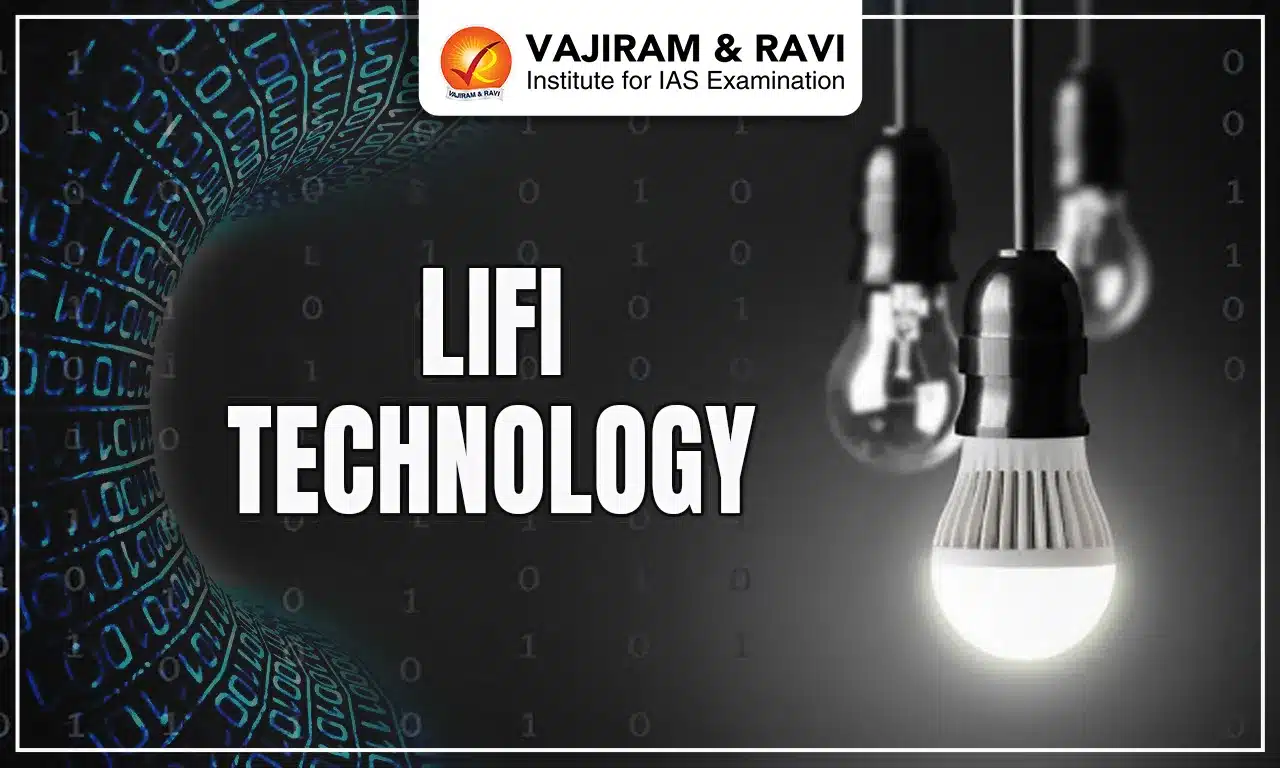LiFi (Light Fidelity) is a wireless communication technology that uses visible light, particularly LED bulbs, to transmit data. It was first demonstrated in 2011 by Professor Harald Haas from the University of Edinburgh, Scotland, who also coined the term LiFi. It provides high-speed, bidirectional, networked mobile communication in a similar manner as WiFi but with higher speeds, lower latency, and a larger bandwidth (thousands of terahertz).
LiFi has the advantage of being useful in electromagnetic-sensitive areas like aircraft cabins, hospitals, and nuclear power plants without causing electromagnetic interference. Its utilisation of unused visible lights in human life has opened up new opportunities in wireless communications technology.
How does LiFi Work?
LiFi works by modulating LED light to encode binary data, which is then received and decoded by photodiodes to transmit data wirelessly using visible light communication. Here is a brief overview of how LiFi works:
- LED modulation - LiFi uses LED bulbs that can be switched on/off rapidly to transmit data through visible light communication (VLC) by modulating light.
- Transmitter encoding - A LiFi transmitter has an LED driver that encodes binary data into on-off light signals. The data rate is varied by changing the flickering rate.
- Receiver decoding - A LiFi receiver photodiode detects light intensity changes caused by objects blocking the beam and converts them back into the original data stream.
- Bidirectional communication - uplink transmitter close to the photodiode modulates the receiver's LED light to transmit data back, forming a bidirectional channel.
- Operating light frequencies - A visible light spectrum from 430 to 770 THz is most suitable for LiFi, as photodiodes are highly sensitive in this range. Infrared or ultraviolet can also be used.
Components of LiFi
The major components of a basic LiFi system are:
- LED transmitter: An LED lamp emits modulated visible light which acts as a data transmission medium. Standard high-brightness white LEDs can be used for better coverage area and illumination.
- Photodiode receiver: Photodiodes sense the transmitted light signals, which are then demodulated to extract the encoded data. High-sensitivity avalanche photodiodes offer high data rates.
- Controller circuit: These circuits drive the LEDs for modulation and manage the timing of data transmission.
- Software stack: It handles aspects like encoding, error control, encryption, and connectivity at the transmitter. Decoding and error correction are done at the receiver.
LiFi Ecosystem
For practical implementation, LiFi technology relies on an ecosystem of the following components:
- Optical access points: These are LiFi-integrated LED fixtures that provide wireless connectivity just like WiFi access points. Ceiling LED lights and bulbs can embed LiFi.
- LiFi dongles: These are the photodiode receivers fitted with antennas and software that can be integrated into client devices like laptops, smartphones, and IoT devices for connecting to LiFi networks.
- Power Lines: Existing indoor power line infrastructure may be leveraged along with lighting for ubiquitous coverage by transmitting data over LED lights as well as existing electrical cabling.
- Optical wireless heads: LiFi femtocells or small optical heads deployed on walls or cubicles can provide local high-speed connections. Can offload data traffic from main optical wireless access points.
- Management system: A centralised software will be required to manage the LiFi integrated lighting infrastructure for optimal performance. Should support handover when moving between optical access points.
- Backhaul integration: Wired backhaul connectivity will be needed between the optical wireless access points, which can be connected to local LAN and internet.
Significance of LiFi
Light (electromagnetic waves) has been used in various applications by humans since time immemorial, but it remains unutilized in our daily lives, other than being used for lighting purposes. Tapping the potential of this unused light for wireless data transfer and the internet is the major hallmark of LiFi. The other significance of the LiFi is as follows:
- High speeds: LiFi can provide internet speeds over 100 Gbps, which is much faster than WiFi. This can enable high-speed applications.
- Security: Light cannot penetrate through walls that contain data within a closed area making it more secure.
- Decentralised means of communication: LiFi is a decentralised means of providing communication due to its working and components.
- Combined with blockchain technology, it can revolutionise the data transfer and communication technology with a quick and secure distributed system of transactions.
- No electromagnetic interference: LiFi uses visible light which does not cause electromagnetic interference. This allows its use in sensitive areas like aircraft and hospitals.
- High density: The visible light spectrum has 10,000 times more bandwidth than radio waves, thus it does not have the problem of ‘spectrum crunch’, as with the radio waves.
- This allows more devices to be connected.
- AR/VR: LiFi helps overcome technology challenges due to non-interference from other EM Waves and being faster, which allows Virtual Reality and Augmented Reality products to become wireless and reliable.
- Industry 4.0: LiFi can also enhance the capabilities industry and fulfill the dream of Industry 4.0 by:
- Increased Automation
- Better Decision-making
- Enhanced Security
- Greater Data Density
- Providing Connectivity in Radio Waves Hostile Industries, etc.
- Environmentally friendly: LiFi uses energy-efficient LED bulbs to transmit data. Being highly energy efficient, it results in lower carbon emissions.
- Cheaper deployment: LiFi can be implemented simply by installing LED bulbs. No new wiring or infrastructure is required making it easy to deploy.
- Prevention of "dead zones": LED bulbs ensure that there are no dead zones as is the case with WiFi routers. Light can easily reach areas inside buildings where radio waves cannot penetrate.
LiFi vs WiFi
LiFi offers several potent advantages compared to WiFi and other wireless communication technologies.
| Parameter | LiFi | WiFi |
| Technology | Visible Light Communication | Radio waves |
| Frequency Band | 430 - 770 THz | 2.4 GHz, 5 GHz |
| Max Speed | Up to 224 Gbps | Up to 54 Mbps (802.11ax) |
| Latency | Low, <1 ms | Medium, >10 ms |
| Security | High, confined to the area illuminated | Medium, can penetrate walls |
| Energy Efficiency | High, uses LEDs | Medium |
| Reliability | High, less interference | Prone to interference |
| Mobility Support | Limited, needs line of sight | Good |
| Outdoor use | Challenging due to sunlight | Excellent |
| Health hazard | None | Concerns about radiofrequency radiation |
| Deployment costs | Low, leverages lighting infrastructure | High for WiFi routers |
Applications of LiFi Technology
LiFi has a diverse range of current and potential applications across various domains.
- Secure and High-speed broadband: LiFi can provide high bandwidth wireless connectivity in indoor spaces such as offices, malls, railway stations and aircraft cabins.
- LiFi is useful in hospitals, power plants and petrochemical facilities since it eliminates electromagnetic interference.
- LiFi provides safe connectivity in environments with flammable gases or chemicals since no electromagnetic sparks are involved.
- LiFi provides precise location-based advertising and tracking since light cannot pass through walls.
- LiFi can enable short-range underwater communications.
- Remote connectivity: LiFi can provide connectivity in rural areas where laying fibre optic cables is difficult. It is also suitable for remote hilly areas with no cellular or network availability.
- Cellular offloading: The load on cellular networks can be reduced by offloading data to optimally placed LiFi networks.
- Vehicles: LiFi is being tested in vehicles for inter-vehicular and vehicle-to-infrastructure communication, collision avoidance and autonomous driving.
- Aviation: It provides high-speed in-flight connectivity for passengers using cabin overhead lights. Reduces aircraft wiring weight.
- Disaster management: It facilitates high-speed optical wireless communication using LiFi and is resilient in case of disasters that damage cellular networks.
- Smart lighting: The future smart lighting with LEDs and LiFi will combine illumination, data connectivity and sensing making cities more efficient.
- Wireless charging: LiFi bulbs can provide wireless charging to devices using resonant inductive coupling along with high-speed data transmission.
- Next-generation networks: 5G networks and beyond will incorporate LiFi to provide ultra-high capacity in dense spaces and relieve the load on radio networks.
- Internet of Things: LiFi is ideal for smart devices and machine-to-machine communication in enclosed industrial and manufacturing environments with multiple sensors.
- Defence and security: It provides high-speed secured wireless communication in border areas, sensitive government installations, and warships that can be enabled by LiFi networks.
Challenges for LiFi Adoption
While LiFi offers advantages over WiFi, there are some challenges to be overcome before it sees mass adoption, including in India.
- Needs line-of-sight: The dependency on the line-of-sight constrains its application in a limited area only.
- Needs unmodulated ambient light: Interference from sunlight and ordinary bulbs may affect the quality of transmission. Filters may be required.
- Device incompatibility: Many existing devices do not have the inbuilt capability to connect to LiFi networks. Dongles or integrated receivers will be essential.
- Initial high costs: Currently, LiFi equipment costs are higher than WiFi but are likely to fall with economies of scale and technology maturity.
- Dependency on lighting infrastructure: Data networks remain affected by faults or switching off lighting systems, unlike WiFi, which is independent.
- Security concerns: Research shows LED bulb outages can be intentionally created to form covert channels for data exfiltration affecting confidentiality.
- Standardisation: Multiple fragmented LiFi standards currently exist. Harmonization into open, unified standards is important for interoperability.
- Health concerns: While believed to be safe, the long-term impacts of prolonged human exposure to flickering LED lights used in LiFi remain unknown.
- Latency: Currently, LiFi has a higher latency compared to WiFi networks, but ongoing enhancements are lowering delays.
- Ultra-low latency is needed for applications like vehicular communications.
Way Forward
LiFi is still in a nascent stage, with active technology development and field trials underway to shape its future evolution.
- Standards development: Standards need to be established for components, networking protocols, and installation practices to ensure interoperability.
- Integration with networks: Integration with existing networks like 5G and WiFi should be improved for complementary benefits.
- Cost reduction: Bringing down costs through technological improvements and economies of scale will drive adoption.
- Policy support: Government policies should incentivise LiFi infrastructure development for public services.
- Private sector collaboration: Collaborations between academia, industry and startups will spur LiFi innovation and commercialization.
Last updated on November, 2025
→ Check out the latest UPSC Syllabus 2026 here.
→ Join Vajiram & Ravi’s Interview Guidance Programme for expert help to crack your final UPSC stage.
→ UPSC Mains Result 2025 is now out.
→ UPSC Notification 2026 is scheduled to be released on January 14, 2026.
→ UPSC Calendar 2026 is released on 15th May, 2025.
→ The UPSC Vacancy 2025 were released 1129, out of which 979 were for UPSC CSE and remaining 150 are for UPSC IFoS.
→ UPSC Prelims 2026 will be conducted on 24th May, 2026 & UPSC Mains 2026 will be conducted on 21st August 2026.
→ The UPSC Selection Process is of 3 stages-Prelims, Mains and Interview.
→ UPSC Result 2024 is released with latest UPSC Marksheet 2024. Check Now!
→ UPSC Prelims Result 2025 is out now for the CSE held on 25 May 2025.
→ UPSC Toppers List 2024 is released now. Shakti Dubey is UPSC AIR 1 2024 Topper.
→ UPSC Prelims Question Paper 2025 and Unofficial Prelims Answer Key 2025 are available now.
→ UPSC Mains Question Paper 2025 is out for Essay, GS 1, 2, 3 & GS 4.
→ UPSC Mains Indian Language Question Paper 2025 is now out.
→ UPSC Mains Optional Question Paper 2025 is now out.
→ Also check Best IAS Coaching in Delhi
LiFi FAQs
Q1. What is LiFi?+
Q2. How does LiFi work?+
Q3. Is LiFi faster than WiFi?+
Q4. What are the advantages of LiFi over WiFi?+
Q5. What are the components of a LiFi system?+
Tags: lifi technology quest





















